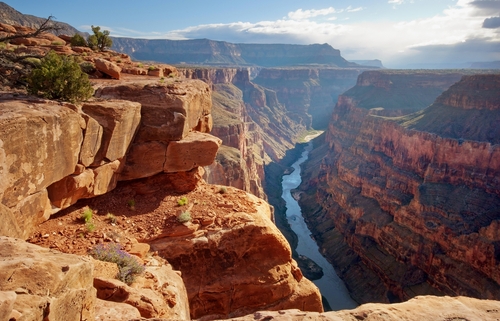Why Fall is the Best Time to Visit the Grand Canyon
The Grand Canyon is one of the most stunning natural wonders in the world, attracting millions of visitors each year.
With its breathtaking views, hiking trails, and outdoor activities, the Grand Canyon is a must-see destination for anyone traveling to the American Southwest. But when is the best time to visit the Grand Canyon?
The answer depends on a variety of factors, including weather, crowds, and personal preferences. In this blog post, we’ll explore the different seasons at the Grand Canyon and help you plan your visit accordingly.
Summer (June-August)
Summer is the busiest time of year at the Grand Canyon, with crowds of visitors from all over the world flocking to this iconic destination.
The weather is warm and sunny, with average temperatures in the 80s and 90s (Fahrenheit). The long days also mean you can spend more time exploring the park, taking in the sights and enjoying outdoor activities like hiking, rafting, and biking.
However, with the popularity of the summer season comes a few downsides. The Grand Canyon is one of the most visited national parks in the country, and during the summer, it can get quite crowded.
This means that parking spots and campsites may be harder to come by, and tours may fill up quickly. If you plan to visit during the summer, be sure to book your accommodations and activities well in advance.
One of the benefits of visiting during the summer is the range of activities available. With the warm weather and long days, you can take advantage of all that the park has to offer.
From hiking to biking to river rafting, there’s something for everyone during the summer months. Just be sure to pack plenty of water, sunscreen, and other essentials to stay safe and comfortable during your visit.
Fall (September-November)
Many visitors consider fall to be the best time to visit the Grand Canyon. The temperatures are cooler than in the summer, with highs in the 60s and 70s, making it a great time for hiking and outdoor activities.
The fall foliage also adds a beautiful touch to the already stunning scenery, with bright oranges, yellows, and reds painting the landscape.
While the crowds are still present, they tend to be smaller than in the summer, making it easier to find parking spots and campsites. Some of the tours and facilities may start to close for the season as the weather cools down, so be sure to check ahead before planning your trip.
One of the highlights of visiting the Grand Canyon in the fall is the chance to see the canyon at its most colorful.
The changing leaves add a new dimension to the already stunning views, making it a great time for photography and sightseeing. The cooler temperatures also mean you can hike and explore without worrying about the heat.
Winter (December-February)
Winter can be a magical time to visit the Grand Canyon, especially if you enjoy snow sports and outdoor winter activities. The canyon is quieter in the winter, with fewer crowds and more solitude. You’ll also get to experience the stunning beauty of the canyon covered in snow, which is a rare sight.
However, the weather can be unpredictable during the winter months, with snow and ice potentially making some trails and roads inaccessible. If you plan to visit in the winter, be sure to check weather and road conditions before you go, and dress appropriately for the cold.
Despite the potential challenges, winter can be a rewarding time to visit the Grand Canyon. With fewer crowds, you can explore at your own pace and take in the natural beauty of the canyon in peace.
You can also take advantage of winter sports like skiing and snowshoeing, or simply enjoy the scenic views from viewpoints like Yavapai Point or Desert View. Just be sure to pack plenty of warm layers and winter gear to stay comfortable during your visit.
Spring (March-May)
Spring is another popular time to visit the Grand Canyon, with mild temperatures and blooming wildflowers adding color to the already stunning landscape.
The temperatures are mild, with highs in the 50s and 60s, making it a great time for hiking and outdoor activities. However, spring can be unpredictable in terms of weather, with occasional rain and even snow.
One of the benefits of visiting the Grand Canyon in the spring is the chance to see the wildflowers in bloom. The canyon is home to a variety of plant life, and in the spring, you can see bursts of colorful flowers like yellow daisies, purple lupines, and red Indian paintbrushes.
It’s also a great time to spot wildlife like elk and bighorn sheep, who come out to feed on the new growth.
The spring months can be busy, especially during spring break season, so be sure to book your accommodations and activities well in advance. However, with the milder temperatures and stunning natural beauty, it’s easy to see why so many visitors flock to the Grand Canyon in the springtime.
Conclusion
The best time to visit the Grand Canyon depends on your personal preferences and priorities. If you enjoy warm weather and don’t mind crowds, summer may be the best time for you. If you prefer cooler temperatures and smaller crowds, fall and spring are great options.
And if you want to experience the stunning beauty of the canyon covered in snow, winter may be the perfect time for your visit. No matter when you go, you’re sure to have a memorable and awe-inspiring experience at one of the world’s natural wonders.
Just be sure to plan ahead, dress appropriately, and take in all that this stunning destination has to offer.
